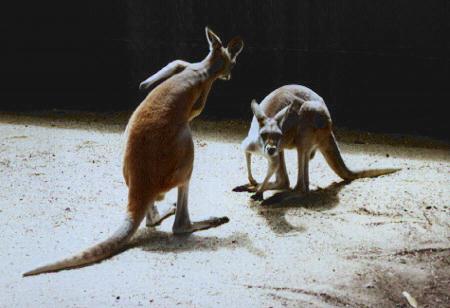Australia before the Europeans.
By Janine Roberts - from her book, 'Massacres
to Mining.' -with some additional research.>

The gorge was narrow, the cliffs low but steep. The sun glared from
the exposed rocks. I clung to the shade as I explored its winding
course. It was dry underfoot but when rare desert rains came it would
turn into a deadly torrent. I was in the Flinders Ranges, the range
of deeply eroded hills that divide the vast salt bush plains of south
Australia.
I had not gone far before I came upon
circles carved deeply into rocks. Then, turning a bend, I entered a
flat sand floored arena. On either side the cliffs were intricately
carved with lines, curves, spirals and circles. It was a strange
place of magic that held me. Clearly this was a place naturally made
for dancing and ceremony. I had been told that Aborigines were so
primitive that they had no writing. Commen prejudice told me that
these were primitive drawings by a tribe unable to draw the realistic
paintings of the north. But suddenly, sitting there, contemplating
them from a rocky seat, I realised that prejudice had blinded me.
These were no poor drawings. They were abstract hieroglyphics
belonging to a written language. I was latter to learn that this
ancient writing was over 23,000 years old - and that it was still
understood by a few surviving descendents today.
Aboriginal people were in Australia over
40,000 years before the first Europeans reached the continent. Some
now say for over 100,000 years. Their culture thus predates by tens
of thousands of years the building of the pyramids in Egypt a mere
4,500 years ago. The Bunggunditj tribe of around Mt. Gambier in South
Australia has in its oral history how Mt. Muirhead erupted (20,000
years ago) and then how Mt Gambier erupted (5,000 years ago). At
Keilor near Melbourne a 31,OOO years old Aboriginal camp has been
found. People then hunted wombat-like creatures, today wild pig sized
animals, then as big as rhinoceroses as well as ten foot high
kangaroos. These became extinct many thousand years ago but they are
still remembered in Aboriginal history told from generation to
generation
Before the British came there were some
500 Aborginal nations, many of whom have now been wiped out, and as
many languages. Each nation or tribe was made up by a number of clans
(and still is). Each clan held (and many still hold) its own land and
they invite others to use it for particular hunts or crops at the
right time. There was no special castes of priests or centralised
systems of authority.
Silas Roberts, an Elder and first Chairman
of the Northern Land Council, explained how they feel about land.
'Aborigines have a special connection with everything that is
natural. Aborigines see themselves as part of nature. We see all
things natural as part of us. All things on earth we see as part
human. This is told through the idea of dreaming. By dreaming we mean
the belief that long ago these creatures started human society; they
made all natural things and put them in a special place. These
dreaming creatures were connected to special places and special roads
or tracks or paths. In many cases the great creatures changed
themselves into sites where their spirits stayed.
My people believe this and I believe this.
Nothing anybody says to me will change my belief in it. This is my
story as it is the story of every true Aborigine.
These creatures, these great creatures,
are just as much alive today as they were in the beginning. They are
everlasting and will never die. They are always part of the land and
nature as we are. We cannot change nor can they. Our connection to
all things natural is spiritual. We worship spiritual sites today. We
have songsand dances for these sites and we never approach them
without preparing ourselves properly. When the great creatures moved
across the land, they made small groups of people like me in each
area. These people were given jobs to do but I cannot go any further
than that here.
It is true that people who belong to a
particular area are really part of that area and if that area is
destroyed they are also destroyed. In my travels throughout Australia
I have met many Aborigines from other parts who have lost their
culture. They have always lost their land and by losing their land,
they have lost part of themselves.'
This is from a speech made by Silas
Roberts opposing the mining of uranium on tribal land.

 Click
to return to the Library Entrance.
To Contact Jani Roberts
Click
to return to the Library Entrance.
To Contact Jani Roberts

